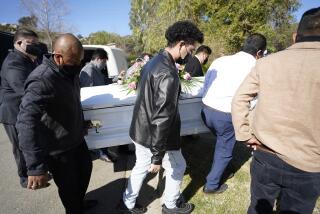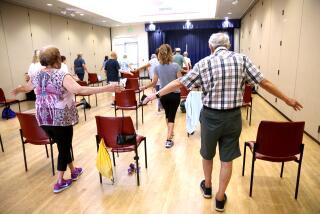In life, genes will only get you so far
BILL Walker’s mother lived to 101, his Uncle Rufus to 102. “I rather expected to live a long life,” says the 89-year-old Long Beach resident. “I think it gave me a different view of aging, compared to some friends who had family members die in their 50s and 60s. They’re looking for the grim reaper every day.”
Harriet Bennish, 56, has lived with no such easy assumption. She feels she dodged a bullet early on -- an infected cyst, discovered shortly after her first pregnancy, that required the removal of a kidney. Since that brush with serious illness, the Long Beach singer and actress has made it a point to exercise daily and eat a mostly vegetarian diet in order to stay as healthy as she can.
Death, its cause and its timing, remains mysterious. Early skirmishes with disease and stark statistics listing leading killers for each decade of life offer clues as to when and how the end will come. So do genes -- parents who died too young or relatives who lived to remarkable ages.
FOR THE RECORD:
Aging: An article in the Oct. 15 Health section identified Dr. Moira Fordyce of Stanford University School of Medicine as a gerontologist, someone with a degree in aging studies who does not practice medicine. Fordyce is a geriatrician, a licensed medical doctor specializing in geriatrics. —
But although the specter of genes looms large in the popular imagination, they can be warning posts, not destiny. “The heritability of human life span is actually rather low,” says Caleb Finch, professor of gerontology at the University of Southern California.
Even identical twins, once they’re in their 70s -- an age that most Americans reach -- are no more likely to die of the same disease than any other two people, he says.
“The genetic influences account for about 30% of aging problems,” says Dr. Moira Fordyce, gerontologist at Stanford University School of Medicine. “The other 70% comes from lifestyle.”
The contribution of genes does wax and wane. We face specific risks depending on our age. From early to mid-adulthood, those risks are based largely on chance and genetics. For people who make it to late adulthood, the risks come down to the biological aging process, known as senescence, that all humans experience.
But even from one’s 30s to one’s 60s, when premature death is often linked to genes through a predisposition to cancer or other disease, the land mines of inheritance often can be avoided.
A family history of early heart attack, for example, is a strong motivator to exercise, control weight and take blood pressure and cholesterol-lowering drugs if necessary, all of which can even the playing field.
A family history of cancer is good reason to take every preventive step possible, including routine screenings.
EARLY deaths are always tragic, sometimes with no more comforting explanation than the hand of fate. Infants and children die of birth defects, SIDS, pregnancy complications and rare childhood cancers.
By adolescence, the leading causes of death are violent: accidents, suicide and murder.
Cancer is an especially insidious threat in midlife. In a June 2003, study in the Journal of Gerontology, Finch and colleagues in Paris looked at patterns of mortality in two distinct age groups of French citizens: 30 to 54 and 65 to 89. They found that in the younger group, the proportion of cancer deaths increased markedly in the 30s, 40s and 50s, accounting for 45% of deaths around age 60.
(There were far more total cancer deaths at older ages, but since there were also vastly more deaths in old age, cancer accounted for less than 15% of deaths at ages 85 to 89 and only 5% of deaths among centenarians.)
A similar pattern holds in the United States for cancer and heart disease, according to 2003 data from the government’s National Center for Health Statistics. And that is why almost everyone in their 50s and 60s has had the shocking news that a friend or relative their age has died an early death from these causes.
(Again, there were many more total cancer and heart disease deaths among the elderly, but they account for a smaller percentage.)
By the mid-30s, there’s a definite fork in the road leading to two fundamentally different paths. Luck is still a player on each path, in the guise of genetic predisposition to disease or lack thereof.
But obesity, poor nutrition habits, smoking, lack of exercise or excessive drinking can send people down a path toward premature death despite good longevity genes.
And good lifestyle habits, cancer screening tests, and cholesterol- and blood pressure-lowering drugs -- even in the face of a family history of early death -- can help people navigate the other path, toward ripe old age.
REGARDLESS of how Grandma and Grandpa died, it’s a good idea to be realistic. Death comes to all. Without dwelling on morbidity, people can eat right, exercise and do what they can to remain as healthy as possible.
“There are people who don’t manage to think about death at all. They might pay a price,” says Dr. Robert Butler, president of the International Longevity Center and Pulitzer Prize-winning author of “Why Survive: Being Old in America.” “You don’t want to spend your life morbidly thinking about your old age and death. But you want some sort of balance between that and total blind faith.”
A stark reminder often comes when parents die. “That’s a call to arms in the reality of life and death,” Butler says. “You see yourself as the next in line.” The best shot at a long and healthy life is to live the healthiest lifestyle possible in the time you’ve got left. Better now than never. “No sense crying over spilt milk,” Butler says. “It’s never too late to start. Take the stairs. Modify your diet.”
Every age has its angst, from the agony of the teenage pimple on prom night to the stressful demands of young adulthood, to the onslaught of wrinkles and the need for that first pair of reading glasses, then the aches and pains that inevitably pile on with the decades.
What’s inside the head is another matter. “Only the shell grows old,” Fordyce says. “In mind and spirit, you feel the same inside.”
Bennish says she has “this magical number inside me. It’s 27,” she says. These days, the acting parts she gets are godmother, grandmother and a character in American Girls Revue known as “White Braids.” But when she’s on her bike, her rollerblades or her hourlong walks, she still feels 27.
Many studies link a positive outlook with a longer life, so if Bennish feels 27, that attitude, along with her healthy exercise and diet routines, could have her acting in age-appropriate roles for decades to come.
Walker left his father’s Michigan farm during the Depression, bought an airplane in 1935 before he ever owned a car, became a military flight instructor during World War II and a civilian flight instructor later, raised two successful sons, ran a pawnshop, survived colon cancer and a robbery beating, and is now studying classical guitar. He is living the long life he always believed was in the cards.
“When I was younger, I figured I was always going to be young,” he says. “I know my body is deteriorating. But I enjoy life so well.”
The greatest satisfaction may be to look in the mirror at some advanced age, continually surprised that the shell looks older than the heart feels.






